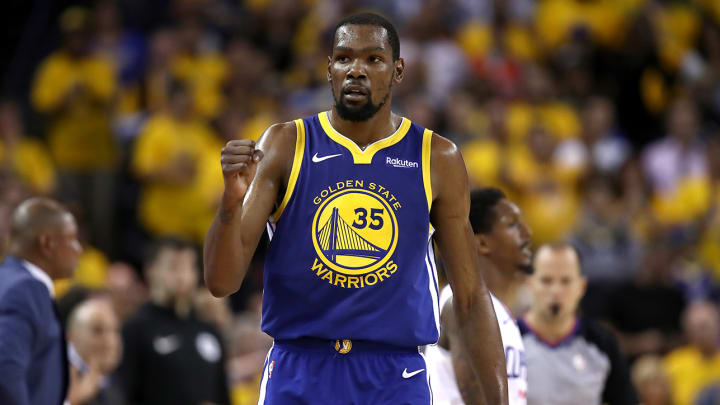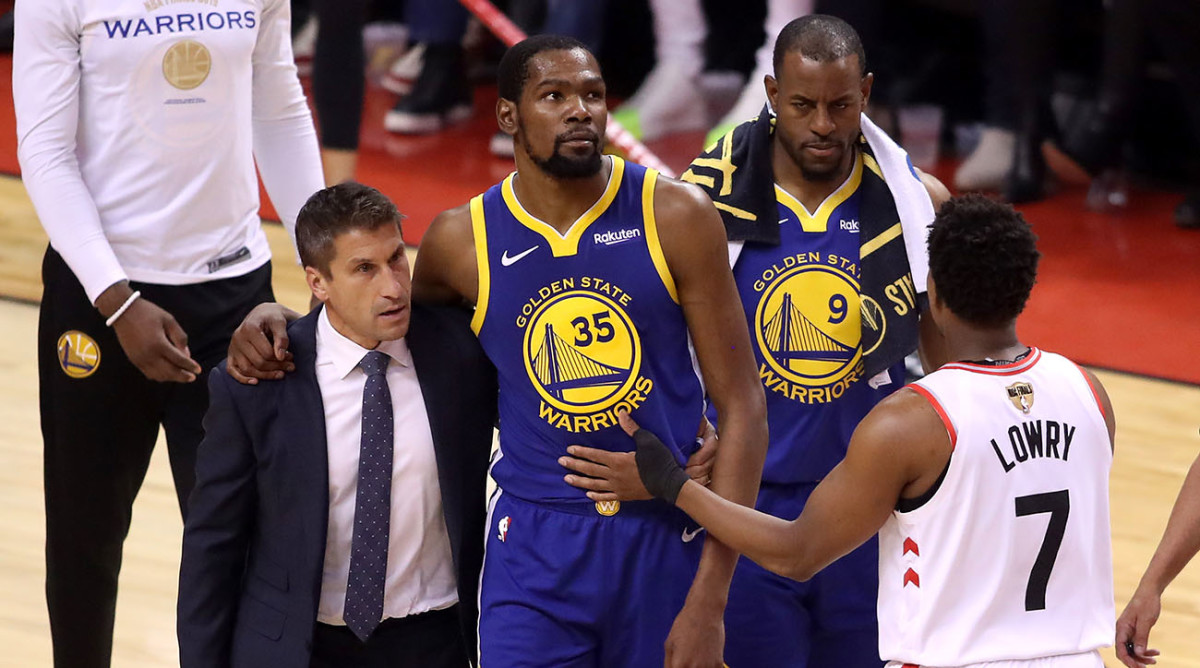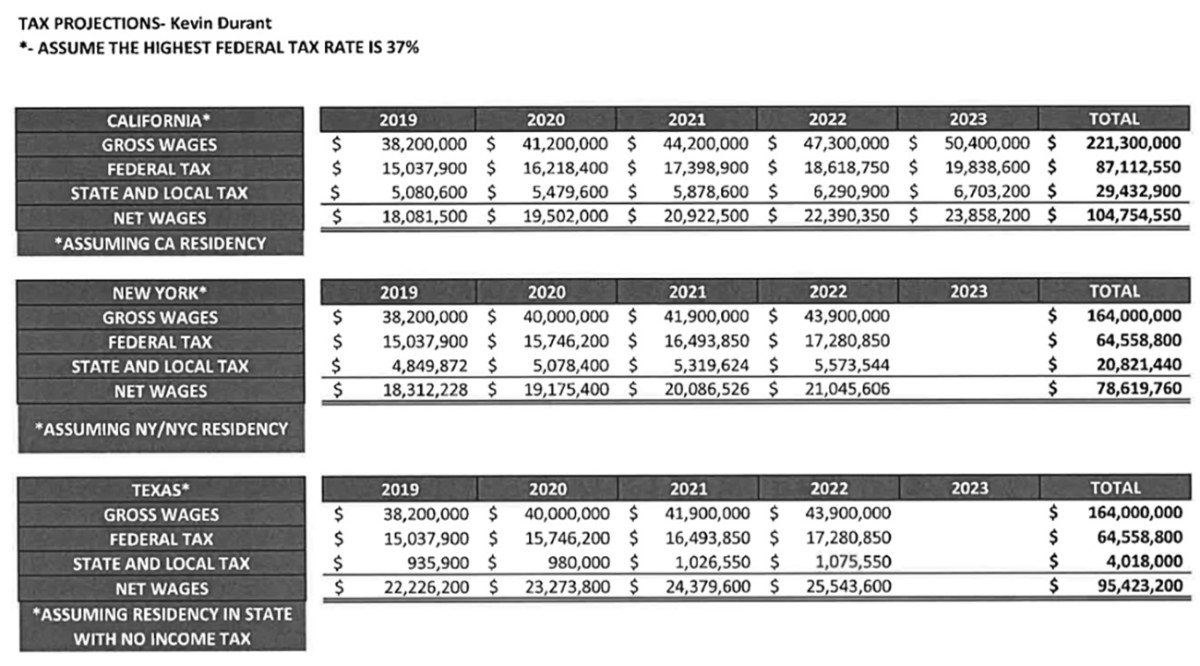Kevin Durant And the Inequality of Max Contract Offers

The winner of the Kevin Durant Sweepstakes will have to wait a year—or possibly longer—for a return on their investment.
Durant will spend the ’19-’20 season recovering from the ruptured right Achilles tendon he suffered during Game 5 of the NBA finals. Despite the fact that Durant will not suit up for any team next season, he has opted out of a contract with the Golden State Warriors that would have paid him $31.5 million over the next year.
Durant will thus be looking for work when NBA free agency begins on Sunday at 6 p.m. ET. At that moment, he’ll become an unrestricted free agent. He’ll also be an injured man without a job.
Basic logic suggests that a person who can’t work for the next year shouldn’t opt out of an employment contract that would guarantee pay for the next year, let alone $31.5 million in pay. Will the 30-year-old former league MVP regret walking away—for now, with just one good leg—from the kind of money that few people earn in a lifetime, never mind in one year?
No.
In fact, Durant is counterintuitively poised to earn a raise, and a substantial one at that, next season.
Durant and his agent, Rich Kleiman, are confident that teams will offer the 10-time All-Star the “max” contract permissible under the collective bargaining agreement. The Warriors can offer Durant a five-year contract worth $221 million while other teams with sufficient salary cap space can offer him a four-year contract worth $164 million.
If Durant signs a max deal with any of the teams, that team would pay him $38.2 million in ’19-’20. He would be paid this amount while he doesn’t play any games. Durant’s pay in the following three seasons would depend on whether he signs with the Warriors or with another franchise. The Warriors, as Durant’s current team, can offer him (in addition to a 5th contract year) annual increases of approximately 8% whereas other teams can offer him approximately 5% annual increases.

Questioning the logic of paying a seriously injured player who can’t play
The wisdom of paying $38 million to a basketball player who can’t play basketball is debatable, if not problematic. Yes, it’s someone else’s money. He or she can do with it as they please. Still, it’s not an expenditure that is obviously sound.
Further, Durant’s injury is one from which he might not fully recover. Achilles tendon injuries are among the worst for pro athletes, particularly basketball players. While Durant will receive world class health care and while medical treatments for Achilles injuries have only improved over time, this kind of injury has adversely impacted, in some cases derailed, the careers of other NBA players.
Even if Durant can regain 95% of his explosiveness and speed, he wouldn’t be the same player. Sure, 95% of Kevin Durant is better than 100% of most players. However, in a league where a max player is not only paid a great deal but occupies a substantial portion of a team’s salary cap, the team that signs Durant is taking on a risk that will substantially influence the remainder of its roster.
Durant is also not getting younger. He’ll be 32-years-old to start the 2020-21 regular season. 32 isn’t “old”, per se, and Durant is one of the 50 greatest players in NBA history. Nonetheless, research indicates the prime of NBA players tends to occur between the ages of 26 to 28.
Durant also has a significant amount of “wear-and-tear” on his legs, which have also suffered injuries over the years. As one of us wrote in a recent Sports Illustrated story on the potential legal fallout of Durant’s injury, Durant has logged about 37,000 minutes over 12 seasons of regular season and playoff games.
The numbers of the Durant sweepstakes
Despite these concerns, the Durant sweepstakes are about to begin. Certain teams are willing to take the chance that Durant will make a full recovery. If the team that signs Durant is correct about that projection, it will have signed one of the top five players in the NBA and a proven champion.
While teams can only offer Durant a maximum amount of salary as dictated the CBA, those teams are located in different states that have very different tax laws. Some of the teams vying for Durant’s services could use those variances to their advantage in negotiations.
According to published reports, the teams considered frontrunners to sign Durant include the Knicks, Warriors, Nets and Mavericks. Other than the Warriors, which as explained above can offer Durant a longer and somewhat more lucrative deal, other teams can only offer Durant the identical “max” four-year contract. Stated differently, the Knicks and Mavericks can’t outbid each other for Durant—each of their “best offers” will offer the same listed value.
Yet the amount of income Durant “takes home” after taxes would be quite different depending on the team he picks. From that lens, each “best offer” might be nominally equal but, in reality, quite different.
Consider our data:

Our assumptions about Durant’s place of residence and the impact of “jock taxes”
Before discussing these calculations, we want to acknowledge three assumptions and clarifications.
First, we assume Durant will reside in the state where he plays. This is an important data point since a taxpayer faces state income taxes based on where they work and where they reside. To illustrate, if you work in New Hampshire, where there is no state income tax, and live in Massachusetts, where there is a state income, you still pay Massachusetts income taxes.
Second, our federal income tax calculation includes “payroll taxes.” This means we factor in the Social Security tax, Medicare tax and the Medicare surcharge in assessing the amount of money Durant would owe to the federal government.
Third, within our state and local tax calculations, we include the impact of so-called “jock taxes.” These taxes are imposed by states and municipalities on the proportion of income attributed to athletes on visiting teams. Jock taxes will hit Durant’s bottom-line and we make sure to recognize their impact in our calculations.
Based on tax law, Durant’s best play is to join the Mavericks or stay with the Warriors
If Durant wants to maximize his after-tax earnings over the next four seasons, he should sign with the Mavericks.
Even though his salary would be lower with the Mavericks than if he stayed with the Warriors, the absence of a state income tax in Texas coupled with the country’s highest state income tax rate in California (a 13.3% marginal rate on income in excess of $1 million) would lead Durant to net substantially more earnings in Dallas over the next four seasons. Specifically, he would take home $95.4 million with the Mavericks versus $80.9 million with the Warriors. During those same four years, Durant would earn less with the Knicks or Nets: $78.6 million. This reflects Durant being subject to an approximately 12.7% tax rate between New York State and New York City. In other words, Durant would take home nearly $17 million more over the next four seasons by signing with the Mavericks over either New York team. To extend this point for a moment, if Durant signs with the Los Angeles Clippers (who are also thought to be in play for his services), he would net the least amount of money. This is because the Clippers would pay Durant nominally the same as the Mavericks, Knicks or Nets but Durant would be subject to California’s 13.3% tax rate.
Alternatively, if Durant wants to maximize his total guaranteed money through this next contract, he should sign with the Warriors. The Warriors can offer a 5th year and a total after-tax value of $104.8 million. If Durant is concerned about how his health will hold up at age 35, the Warriors would be an especially sensible landing spot.
Durant’s decision might also be influenced by the most recent federal tax law overhaul, the Tax Cuts and Jobs Act (TCJA). Signed into law by President Donald Trump, the TCJA reduces from 39.6% to 37.0% the federal income tax rate that applies to the highest earners (which is defined as single persons who earn more than $510,300 a year or married persons who earn more than $612,350 a year and file jointly). The reduction certainly benefits Durant, who is reportedly not married. Almost all of his income will exceed the $510,300 threshold.
Yet Durant might also “suffer” by the TCJA’s treatment of deductions, which are specific types of offsets—including payments on mortgage interest, home office expenses and amounts paid on property, state and local income taxes—from the amount of a person’s income subject to federal income taxes. Taxpayers can elect to take the “standard deduction” (which is currently $12,200, $18,350 or $24,400 depending on filing status) or itemize. Itemizing is exactly what it sounds like: listing or itemizing offsets, presumably because on a whole they exceed the standard deduction. Usually persons who earn significant income itemize, in part because they tend to pay high levels of state and local taxes.
Under the TCJA, however, itemizing for state and local taxes is capped at $10,000, meaning more of the taxpayer’s income is subject to taxes. If Durant signs with an NBA franchise in New York or California, both of which have very high state and local taxes, Durant might, on balance, “lose out” under the TCJA.
We know money is not the only factor, and we know Durant already has a lot of money
Before you tell us that Durant’s decision “it’s not just about the money!!,” we fully agree.
Players, like everyone else, make job decisions that weigh family considerations, cultural preferences, weather likes and dislikes and numerous other influences. NBA players are also mindful of which team can realistically compete for a title, as well as how well they would fit in with would-be teammates and coaches.
Durant also already has a ton of money. According to Basketball Reference, the Warriors, Oklahoma City Thunder and the Seattle Supersonics have collectively paid Durant $160 million since he entered the league as the number two pick in 2007 NBA Draft. Durant’s endorsement deals with Nike, Google and other brands have also paid him tens of millions of dollars. Durant’s next NBA contract might not have a major impact on his day-to-day life since he is already very rich.
We certainly don’t claim that money is everything, nor do we have reason to believe that Durant is in it mainly for money. It’s that after-tax earnings constitute one factor, and as shown above, the Mavericks and Warriors have a sizable edge over the Knicks and Nets.
Roles of cost of living and endorsement opportunities
The Mavericks also have an advantage when it comes to real estate values, property taxes, groceries prices, gasoline costs and numerous other data points that fall under “cost-of-living” calculations. To that end, a dollar in Dallas is effectively worth more than one in San Francisco or New York. According to Bankrate.com, a person moving from San Francisco to Dallas would experience a cost of living savings of approximately 43%. In other words, $164 million in San Francisco is roughly worth $235 million in Dallas.
Then again, New York and California would offer Durant proximity to much larger media markets. That, in turn, could in turn help him land endorsement deals.
Such logic, though, has a couple of flaws. First, advertisement executives are skeptical that, in today’s world of instant communications and cameras everywhere, geography is meaningfully impactful for endorsement deals. Second, Durant is already an established brand. He could play in an any NBA city and remain extremely marketable, just like he was in Oklahoma City (the 45th largest U.S. media market, behind Birmingham and Norfolk).
Durant has much to weigh in his decision, and as detailed above, max contracts of equal value are really not of equal value.
Michael McCann is SI's legal analyst. He is also the Associate Dean for Academic Affairs at the University of New Hampshire School of Law.
Robert Raiola is the Director of the Sports & Entertainment Group of the CPA and Advisory Firm PKF O’Connor Davies.
